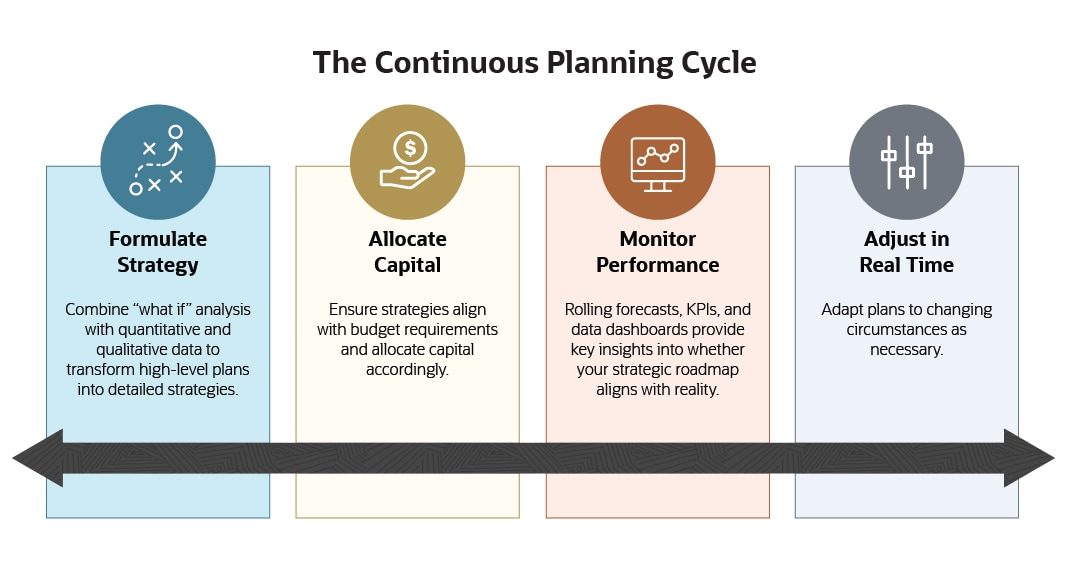Every business must be able to quickly respond to external factors and adapt to shifting priorities. One way to stay ahead of the game is through continuous planning. This approach eschews the traditionally siloed and static plans of the past in favour of constant, collaborative decision-making that drives innovation. Relying on real-time data, continuous planning puts companies in sync with an ever-changing business landscape, allowing management to base their decisions on the most current and accurate information available.
What Is Continuous Planning?
Continuous planning is a method of business planning and budgeting that emphasises ongoing and iterative updates rather than traditional annual or quarterly budgeting cycles. Instead of creating a single business plan or budget on a yearly or biannual basis, companies perpetually monitor internal performance and external influences to inform proactive changes and make snappy decisions. The goal is to increase resiliency in the face of updated business goals and changing market conditions.
Key Takeaways
- Continuous planning is an approach to business planning that embraces change and emphasises responsiveness.
- Using real-time business data, leadership can revise strategies and financial plans on a rolling basis.
- This highly adaptive approach to planning lays the foundation for greater collaboration among stakeholders.
- In setting up a continuous planning strategy, leadership may encounter hurdles, such as old-school thinking and legacy technologies.
Continuous Planning Explained
With continuous planning, business decisions are made more frequently and, ideally, with greater precision and business-wide collaboration than traditional, static planning methods. Guided by such a dynamic vision, business management teams are better equipped to pinpoint pain points, make more reliable projections and implement plans that can carry their companies into the future.
Continuous planning also improves business outcomes. Agile or dynamic planning approaches provide leaders with the tools to quickly respond to possible issues, such as capricious market trends, internal inefficiencies and external disruptions — anything from port congestion to new competitor initiatives. Fluid goals can therefore be tweaked to align with changing circumstances, giving companies the freedom to pivot to what’s necessary for optimal growth — even if new objectives don’t perfectly align with the quarter before. Continuous planning also replaces archaic, rigid processes with a culture that embraces change, collaboration and the desire to continuously improve, supporting innovation and potentially benefiting all teams and stakeholders.

Benefits of Continuous Planning
Aside from enabling organisations to quickly adapt, react and pivot when situations change, continuous planning makes organisations more nimble in other ways, too. By leveraging current and accurate data, for example, finance or FP&A teams can budget better, communicate and collaborate more effectively, and enhance efficiency. Here are some benefits of continuous planning:
- Smoother budgeting processes: Access to more accurate information in the cloud (as opposed to clunky spreadsheets) and more precise financial forecasting capabilities help eliminate unexpected impediments to the budgeting process. By continuously tracking metrics, potential speed bumps, such as inadequate funding or overbudgeting, become more visible. Then finance teams can periodically tweak budgets to stay on track rather than going back to the drawing board to reforecast annual plans. Managing small, incremental changes throughout the year is far more effective than devising rigid annual plans — similar to how keeping the kitchen tidy as you cook reduces the need for a big cleanup at the end.
- Better communication: With continuous planning, decisions aren’t left for later; participants are empowered to make them frequently. But this approach can’t work without constant, transparent communication. As a result, continuous planning supports an ongoing discourse that builds trust and ensures everyone in the organisation is on the same page. Better yet, when direct communication is informed by reliable data, executives and teams can come together and talk in absolutes rather than basing decisions on a gut feeling — paving the way for more detailed, actionable plans.
- Improved teamwork: When all teams within the company use a single, integrated platform, leaders from all business functions have more access to business-wide information. Shared data helps break down silos, making once-disparate teams more capable of collaboration. Teams can then work together to gain traction toward goals and make well-informed decisions that are more likely to improve overall business performance.
- Increased confidence in forecasting: Regularly and continuously updating forecasts builds confidence in the reliability of the planning process. This confidence increases trust among stakeholders and investors.
- Greater efficiency: No longer saddled with plans or budgets, business teams can quickly formulate, revise and execute beneficial changes. For example, access to automated data analysis tools that clearly reveal important business insights in real time gives leaders in any business unit the ability to quickly assess performance. This helps reduce the time between analysis and decision-making, making it easier to pivot when necessary.
Challenges of Continuous Planning
Continuous planning embraces dynamic processes, like rolling forecasts(opens in a new tab) and performance monitoring, lending organisations a leg up in a world that never stops moving. That said, not every company is in a position to quickly adapt to change. Some of the challenges to putting continuous planning into play include:
- Limited resources: While high-growth organisations(opens in a new tab) understand how important it is to move with the times and expand operations when the opportunity arises, not every company has access to budgets that meet stepped-up needs. Similarly, some companies lack the right technologies or employee talent to set them on a progressive path. For example, if an organisation is still relying on inflexible technology, such as outmoded enterprise software that lacks integration capabilities, decision-makers likely can’t access the real-time data required to successfully use continuous planning methods.
- Old-school logic: Some stakeholders may be concerned that continuous planning is too complex to manage or implement. They may also be reluctant to update their annual or biannual planning methods or expand their traditional ways of thinking about strategic planning. This is often rooted in a rigid company culture, where employees are expected to follow established procedures and decisions are left to only those with the highest level of power and authority. This mentality can slow down the decision-making process and hinder innovation.
- Resistance to change: Shifting business environments, technological innovations and in-flux consumption patterns are all factors that can impact an organisation’s planning calendar. Though stability can be comforting, companies that fail to move with the times risk being left behind. Rigid planning makes it hard to consider new variables and projections, leaving a company more vulnerable to stagnation.
- Short-Term Focus: Due to the iterative nature of continuous planning and forecasting, there can be more focus on short-term goals and deadlines rather than considering the long term goals and broader strategic vision.
- Poor data quality and accessibility: Even if an organisation has the technical prowess and progressive mindset needed to adopt continuous planning, its progress may be stunted if it’s relying on inaccurate or outdated data, or it lacks the ability to easily analyse and share findings. Without access to accurate, real-time data, models and forecasts, stakeholders are less able to make truly informed decisions or set the course for future initiatives. But it’s a different story when those capabilities are in place: Companies that use business intelligence as its foundation for planning operate from a position of strength.
How to Establish a Continuous Planning Process
Rolling plans based on high-quality, business-wide data allow stakeholders to make fact-based decisions and update predictions on the fly. But agile planning doesn’t come together overnight. Establishing a successful process entails the following best practises.
1. Formulate Strategy
The first step in the continuous planning process is strategy formulation. Business leaders must understand the organisation’s desired direction and the actions needed to reach that target. A few useful ways to strategise include:
- Statistically driven planning models, which leverage quantitative data, like sales figures and market trends, to identify patterns and predict future performance. These plans generally allow for more seamless changes to finance-based strategies, such as revenue projections and labour and expense plans.
- Initiative-driven planning models, which focus on more qualitative goals and the specific actions needed to achieve desired outcomes. These plans rely less on data analysis and more on strategic thinking, making them a good option in situations where creativity and innovation are key.
- Strategic scenario planning, also known as “what-if” analysis, scenario planning(opens in a new tab) helps teams understand plausible outcomes and how those outcomes can positively or negatively impact organisational goals. Knowing and visualising what could happen can help decision-makers zero in on what initiatives will support organisational goals in a variety of circumstances. This forms a solid foundation for a continuous planning strategy and empowers companies to proactively shift gears when necessary.
By combining scenario planning with quantitative and qualitative data, leaders can transform high-level plans into detailed, real-world strategies — and gain clarity into the impact of each initiative on budget targets.
2. Allocate Capital Accordingly
If a company wants a project to succeed, it needs to appropriately allocate capital to fund the initiative. Without capital, company goals remain out of reach, creating competitive disadvantages and hindering a growth mindset. But extended planning analysis (XPA)(opens in a new tab)must be aligned. Available funding helps dictate the optimal path to success.
Of course, capital allocation comes with its own challenges. Limited capital availability and uncertain ROI aside, multiple departments or business units might compete for the same resources, making it hard to fairly and efficiently allocate capital. In some cases, companies might resort to awarding money requests to those who ask first, rather than those who deserve it most, at that very moment. The problem is, this is old thinking rooted in a bureaucratic mindset — not the flexible approach needed to support optimal performance.
To revamp the capital allocation process with continuous planning in mind, businesses should aim to create standardised capital request forms that obligate applicants to clearly define how the project aligns with strategic goals. Submissions for capital should be evaluated and reviewed according to those goals and available funding.
3. Monitor Performance
Continuous planning doesn’t operate without oversight. To reap the rewards of adaptive planning, leaders must stay on top of strategies and financial plans. By monitoring the company’s strategic vision — and comparing it with external influences — teams can ascertain whether their current roadmap is aligned with reality and on track to reach targeted results. Performance tracking also helps identify issues and where they’re coming from. Two key ways to facilitate monitoring proficiency are rolling forecasts and data dashboards.
Rolling forecasts provide a trended projection of performance over an extended period, often as much as 12, 18 or 24 months into the future. Projections are continually updated throughout that time, based on the most recent data available. This makes it easier to reforecast if market conditions change or unexpected events occur — perhaps supply chain disruptions jack up transportation prices, raising the question of whether a retailer should increase prices in tandem.
Data dashboards(opens in a new tab) give teams an at-a-glance peek at key performance indicators (KPIs) and milestones in real-time. They use clear, concise and informative visualisations to provide decision-makers with the quick insights needed to get the job done. For example, say a retail company’s leadership team uses a data dashboard to track sales data in real time. This includes metrics such as sales volume, revenue and customer demographics. When sales suddenly dip, the dashboard automatically alerts the business to what product line is underperforming and in what demographic. The company can quickly switch gears to improve that product’s marketing strategy to better meet that demographic and get an edge on competitors.
With strong monitoring capabilities, business leaders can readily call out initiatives that fall short of goals, investigate pertinent KPIs, compare performance against objectives and devise plans to course-correct where needed.
4. Adjust Plans in Real Time
The core goal of continuous planning is to support an organisation’s ability to rapidly change direction. With plans, budgets and performance goals in mind — and constant monitoring of each — companies are in a better position to adapt to changing circumstances.
For example, let’s consider a manufacturer that wants to release a new line of products in a new market within the next year. The company creates a detailed plan that outlines key milestones, from securing necessary regulatory approvals and setting up local operations to launching a marketing campaign. As part of its continuous planning process, the manufacturing company’s leadership meets regularly with project managers to assess progress and identify issues.
During the second quarter of the project, they learn that a major competitor is launching a similar product line in the same market, pushing the manufacturer to adjust plans. Leadership decides to accelerate its marketing campaign to reach customers before the competition gains traction. They also adjust their pricing strategy to better compete.
As the project progresses, the manufacturer finds that local regulations are more complex than anticipated, potentially delaying product launch. As a result, leadership decides to instead focus on launching a subset of the product that isn’t subject to the same regulatory requirements. This helps them get to market faster, while continuing to work on obtaining approvals for the main product.
Rather than staying locked into its initial plan, the manufacturer uses continuous planning to better adapt to unexpected changes and challenges, make more informed decisions and ultimately gain a competitive edge.
Build Success with Continuous Planning and Budgeting in NetSuite
An agile approach to planning allows organisations to react quickly to market volatility in an unpredictable world. But to realise the benefits of continuous planning, organisations need to implement the right tools: ones that automate complex processes, allow for companywide planning and easily produce data-informed forecasts and budgets.
do all that and more, putting an end to siloed planning and giving all stakeholders real-time visibility into critical business data. This cloud-based platform expedites daily financial transactions, assists with scenario modelling and reporting, supports more frequent budgeting and forecasting plans, and provides a window into the performance of all teams across the business. The platform also integrates with key business applications, including customer relationship management (CRM) software, inventory management software, and human capital management software, providing a single, seamless way to operate your business.
Before diving into continuous planning, it’s imperative for business leaders to understand the goals they want to achieve, which initiatives take priority and how milestones can realistically be met. Leaders also need to be ready for change — and ready to invest in technology that makes real-time, accurate business-wide data accessible.
Once off the ground, continuous planning requires ongoing maintenance and regular decision-making. This means leaders must continually monitor internal company performance and goals, as well as external factors, such as socioeconomic shifts and changing customer demand. That constant influx of data is used to shape ongoing decisions that help make a business more agile and resilient — traits necessary to stay competitive in today’s ever-changing business environment.
#1 Cloud
Accounting
Software
Continuous Planning FAQs
What is continuous planning in organisational learning?
Organisational learning is the process by which a company draws on the experiences and learnings of its employees, teams and departments. The goal is to use this knowledge and experience to improve the organisation as a whole. Organisational learning is integral to the process of continuous planning because sharing key business knowledge and experiences enables leaders to react to internal and external changes, and subsequently revise business strategies on a rolling basis.
What are continuous planning tool examples?
Some tools often implemented throughout the continuous planning process include enterprise resource planning (ERP) solutions that integrate business data and streamline processes, workflow automation tools that can expedite project approvals, dynamic forecasting and budgeting tools that easily allow leadership to course correct when needed, and dashboards and other business intelligence tools that support traditional reporting tools by streamlining the decision-making process and making it easier to share data across the company.
Why is continuous planning important in agile?
Continuous planning is a critical component of agile methodologies because it aligns with the culture of collaboration, innovation and accelerated project management practises that agile seeks to establish. Continuous planning prioritises continually updated plans that quickly respond to shifting priorities, business circumstances and feedback from team members.
Is strategic planning continuous?
Strategic planning is an ongoing, evolving process that relies on business data to optimally establish priorities, allocate resources and achieve business goals. Strategic planning relies on regular reassessment, but it is generally not considered “continuous” in the same way that continuous planning is. While strategic plans should be routinely updated, the planning process typically isn’t made on a rolling basis like continuous planning, which is more active.
Why is continuous planning important?
Continuous planning is important because it helps companies stay agile, responsive and adaptive to changing circumstances. This helps companies better respond to internal or external pressures and opportunities, ultimately leading to better business performance.
What are the 4 types of planning?
The four basic types of planning are operational, strategic, tactical and contingency. Operational planning is short-term planning used to effectively conduct day-to-day operations. Strategic planning is long-term planning used to achieve organisational goals and objectives. Tactical planning is medium-term planning used to implement specific strategies that are necessary to achieve long-term strategic plans. Contingency planning involves planning for unexpected and potential crises to minimise business disruption and ensure continuity.
What are the three elements of the continuous planning process?
Three key elements of the continuous planning process are aligning strategies with budget requirements, consistently monitoring internal business performance and external factors, and making real-time adjustments to plans based on changing business needs









